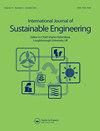Building resilience towards a range of alternative earth futures
IF 3.6
Q3 GREEN & SUSTAINABLE SCIENCE & TECHNOLOGY
International Journal of Sustainable Engineering
Pub Date : 2021-11-02
DOI:10.1080/19397038.2021.2009208
引用次数: 0
Abstract
The devastating impacts of increasingly frequent and wideranging climatic events from tornadoes to hurricanes, wild floods to extreme droughts, freezing cold to extreme heat periods, melting ice and sea level rises to wildfires and deforestation have rapidly evolved the global mindset from climate change to climate crisis, and public demands for climate emergency declarations. The unprecedented level of global ‘eco-enthusiasm’, in particular among younger generations whose quality of life is most likely to be deeply affected, appear to have finally gained the desired traction among key decision makers and stakeholders. The COP26 conference in Glasgow was the largest gathering of governments, industrial leaders and community representatives who appeared to compete in shining the light on their sustainability aspirations and firm commitments to reduce negative impacts on the environment. There was a clear and unstoppable excitement prior to this gathering, seeing this as a critical moment in history with potential to make notable changes towards a sustainable future. Undoubtedly, the long-term successes or failures of COP26 will be scrutinised and assessed in the coming weeks and months, however, a common observation among activists is that the agreements on improvement and reduction targets are not ambitious enough to address the urgent needs and investment commitments are not proportional to size of the challenges ahead. For example, the United Nations Emissions Gap Report (2021) stated that the planet was on course for a dangerous 2.7°C of global warming just before COP26. Based on new announcements made during the Conference, it is estimated that we are now on a path to between 1.8°C and 2.4°C of warming, with further agreement among signatories to revisit their commitments by the end of 2022 to ‘keep the 1.5°C ambition under the Paris Agreement alive’ (COP26 2011). The paramount importance of the role of engineering research and innovation to achieve short-term targets (now until 2030) to build a sustainable future, encapsulated by the United Nations Sustainable Development Goals (UN-SDGS 2015), is now very well defined and understood. But, perhaps the most significant lesson from COP26 is the recognition and final acceptance of paralysing complexities in generating global, coherent and transitional strategies and plans to avoid irreversible changes in our eco-system. This highlights the importance of long-term targets (2030–2050) to become resilient towards a set of alternative ‘earth futures’ that are emerging due to the common reality of the current climate crisis. In this context the key research questions, therefore, are ‘how do we identify and define these alternative earth futures?’ and ‘what are the long-term engineering challenges in building resilience towards these futures?’. Among the many roadmaps and scenarios that have been published, one approach is the utilisation of a two axes scenario planning methodology. This has been used for many years to improve the quality of strategic planning in various applications, and in particular to identify the critical factors that will shape our eco-system futures. Readers are referred to Rahimifard et al. (2013) for further details. The proposed critical factors in this study are firstly the severity of our negative impacts on the environment that were extensively discussed at COP26 and secondly the rapid depletion of resources which perhaps has not been deliberated to the same extent but would undeniably have immeasurable economic and socio-political consequences in the way that the global population will maintain lifestyles. Using these factors, Figure 1 depicts four possible scenarios (or futures) for the eco-system in our planet, labelled as follows:建立一系列替代地球未来的弹性
从龙卷风到飓风,从洪水到极端干旱,从严寒到极端高温,从冰雪融化和海平面上升到野火和森林砍伐,越来越频繁和范围越来越广的气候事件的破坏性影响迅速使全球思维从气候变化转变为气候危机,并使公众要求宣布气候紧急状态。全球前所未有的“生态热情”,特别是生活质量最有可能受到深刻影响的年轻一代的“生态热情”,似乎终于在关键决策者和利益攸关方中获得了预期的牵引力。在格拉斯哥举行的COP26会议是政府、工业领袖和社区代表的最大聚会,他们似乎在竞争,以彰显他们的可持续发展愿望和减少对环境的负面影响的坚定承诺。在这次会议之前,人们明显感到兴奋,认为这是历史上的一个关键时刻,有可能朝着可持续的未来做出显著改变。毫无疑问,COP26的长期成功或失败将在未来几周和几个月内被仔细审查和评估,然而,活动人士普遍认为,关于改善和减少目标的协议不够雄心勃勃,不足以解决迫切需求,投资承诺与未来挑战的规模不成比例。例如,《联合国排放差距报告(2021年)》指出,就在第26次缔约方会议之前,地球正朝着2.7°C的全球变暖危险方向发展。根据会议期间发布的新公告,估计我们现在正走在1.8°C至2.4°C的变暖道路上,各签署国进一步同意在2022年底之前重新审视其承诺,以“保持《巴黎协定》1.5°C的目标”(COP26 2011)。工程研究和创新对于实现联合国可持续发展目标(UN-SDGS 2015)所概括的短期目标(从现在到2030年)、建设可持续未来的作用至关重要,这一点现在得到了很好的定义和理解。但是,也许COP26最重要的教训是,认识到并最终接受了在制定全球连贯的过渡性战略和计划以避免我们的生态系统发生不可逆转的变化方面令人瘫痪的复杂性。这突出了长期目标(2030-2050年)的重要性,以适应由于当前气候危机的共同现实而出现的一系列替代“地球未来”。因此,在这种背景下,关键的研究问题是“我们如何识别和定义这些可供选择的地球未来?”以及“在建立应对这些未来的韧性方面,有哪些长期的工程挑战?”在已发表的许多路线图和情景中,一种方法是利用双轴情景规划方法。多年来,它一直被用于提高各种应用中战略规划的质量,特别是用于确定将塑造我们生态系统未来的关键因素。读者可参考Rahimifard等人(2013)了解更多细节。本研究中提出的关键因素首先是我们对环境的负面影响的严重性,这在COP26上得到了广泛的讨论,其次是资源的迅速枯竭,这可能没有得到同样程度的审议,但不可否认的是,它将以全球人口维持生活方式的方式产生不可估量的经济和社会政治后果。利用这些因素,图1描绘了地球生态系统的四种可能情景(或未来),标记如下:
本文章由计算机程序翻译,如有差异,请以英文原文为准。
求助全文
约1分钟内获得全文
求助全文
来源期刊

International Journal of Sustainable Engineering
GREEN & SUSTAINABLE SCIENCE & TECHNOLOGY-
CiteScore
7.70
自引率
0.00%
发文量
19
 求助内容:
求助内容: 应助结果提醒方式:
应助结果提醒方式:


